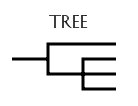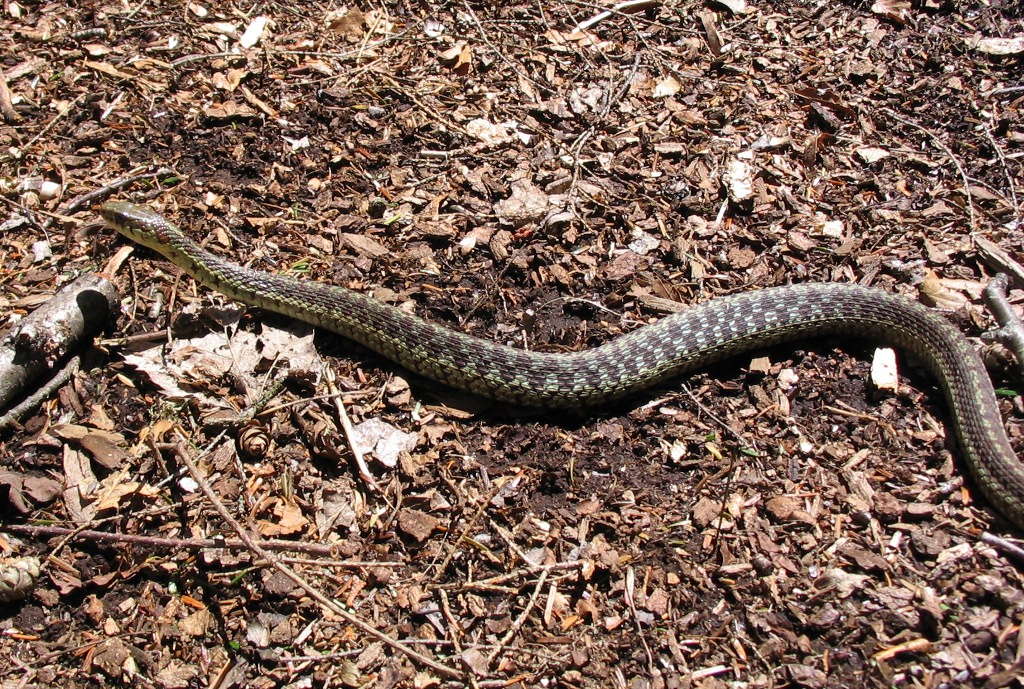| | Eastern Garter Snake (Thamnophis sirtalis). Garter snakes are some of the more common and widespread snakes in North America.
Chapter Outline- Description of Sauropsida
- Classification of Sauropsida
- Sphenodontia
- Squamata
- Serpentes
- Testudines
- Crocodylia
- Paleo Sauropsida

NCBI Tree | Paleo Tree
Links to external sites will appear in pop-up windows. | | |
On the previous page, we saw various groups of legless, or nearly legless, lizards: the families Anguidae, Dibamidae, Xenodermidae, Anniellidae and the parvorder Amphisbaenia. These lizards, though superficially similar to snakes, are not snakes. Depending on the group of lizards, differences can be that they have eyelids, ear openings, inflexible jaws, different skin, or a tail that can be dropped and regenerated. There can be other, more subtle differences too. Snakes do not have eyelids or ear openings, they can unlock their jaws to eat larger prey than they could otherwise, and they are covered in scales. And if a snake's tail comes off, it's not growing back, even if the snake lives.- Sauropsida
- Lepidosauria
- Sphenodontia - Tuataras (36-III)
- Squamata - Lizards and Snakes (36-IV)
- Dibamidae (bottom of this page)
- Xenodermidae (bottom of this page)
- Bifurcata
- Gekkota - Geckos
- Unidentata
- Scinciformata - Skinks, Spinytail Lizards, Plated Lizards
- Episquamata
- Laterata
- Toxicofera
- Anguimorpha
- Iguania
- Serpentes
- >>> Paleo Tree - Mosasaurs, etc.
- Archelosauria
- Testudinata
- Testudines - Turtles (36-VI)
- Archosauria
- Crocodylia - Crocodiles (36-VII)
- Dinosauria - Dinosaurs
- Ornithischia
- Saurischia
- (various dinosaurs)
- Aves - Birds (Chapter 37)
The infraorder Serpentes contains the snakes. It is split into four superfamilies:- Acrochordoidea
- Colubroidea
- Henophidia
- Typhlopoidea
One of the most unique things about this superfamily of snakes is the texture of their skin. Instead of the "normal" scales found on most snakes, the scales on these snakes stick up into points, which gives them the feel of a coarse file. As of 2024, 0 species of Acrochordoidea have been observed in iNaturalist in the US and 3 throughout the world. - FAMILY ACROCHORDIDAE - FILE SNAKES
- Little File Snake (Acrochordus granulatus) - most iNat observations in the world for Achrochordoidea - SE Asia and India
The superfamily of Colubrid Snakes, Dipsadine Snakes and Vipers. As of 2024, 165 species of Colubroidea have been observed in iNaturalist in the US and 2,357 throughout the world. - FAMILY COLUBRIDAE
- SUBFAMILY CALAMARIINAE
- SUBFAMILY COLUBRINAE
- Glossy Snake (Arizona elegans) - 6 (SCZ)
- Eastern Indigo Snake (Drymarchon corais couperi) - 6 (Omaha Zoo)
- Mandarin Rat Snake (Euprepiophis mandarinus) - 6 (SCZ)
- Grey-Banded Kingsnake (Lampropeltis alterna) - 6 (SCZ)
- Western Milksnake (Lampropeltis gentilis) - Perry Lake, KS
- Common King Snake (Lampropeltis getula) - SCZ
- Honduran Milk Snake (Lampropeltis triangulum hondurensis) - 6 (KC and Omaha Zoos)
- Great Plains Rat Snake (Pantherophis emoryi) - 6 (SCZ)
- Corn Snake (Pantherophis guttatus) - 6 (KC and Omaha Zoos)
- Rat Snake (Pantherophis obsoletus) - Perry Lake, KS
- Leafnose Snakes (Phyllorhynchus)
- Louisiana Pine Snake (Pituophis ruthveni) - 6 (SCZ)
- Bull Snake (Pituophis catenifer sayi)
- Rhino Rat Snake (Rhynchophis boulengeri) - 6 (Omaha Zoo)
- Central American Tiger Rat Snake (Spilotes pullatus) - 6 (Omaha Zoo)
- Cape Twig Snake (Thelotornis capensis) - 6 (SCZ)
- SUBFAMILY NATRICINAE
- Watersnake (Nerodia sipedon) - Perry Lake, KS
- Dekay's Brown Snake (Storeria dekayi) - Perry Lake, KS
- Garter Snakes (Thamnophis spp.) - Nearly all of temperate and tropical North America
- Eastern Garter Snake (Thamnophis sirtalis sirtalis) - NOAH - Adirondacks
- Red-Sided Garter Snake (Thamnophis sirtalis parietalis) - SCZ
- FAMILY DIPSADIDAE
- Ring-Necked Snake (Diadophis punctatus) - 6 (Konza)
- Western Hognose Snake (Heterodon nasicus) - 6 (SCZ)
- FAMILY ELAPIDAE
- Cape Coral Cobra (Aspidelaps lubricus) - OKC Zoo
- East African Green Mamba (Dendroaspis angusticeps) - 9 (ABQ Biopark)
- Black Mamba (Dendroaspis polylepis) - 6 (Omaha Zoo), 9 (ABQ Biopark)
- Sonoran Coral Snake (Micruroides euryxanthus) - 9 (Sonoran Desert)
- Eastern Coral Snakes (Micrurus fulvius) - 2 (Everglades)
- Indochinese Spitting Cobra (Naja siamensis) - 6 (SCZ)
- King Cobra (Ophiophagus hannah) - 6 (SCZ), 9 (ABQ Biopark)
- FAMILY HOMALOPSIDAE
- Tentacled Snake (Erpeton tentaculatum) - 6 (SCZ)
- Puff-Faced Water Snake (Homalopsis buccata) - 6 (SCZ)
- FAMILY HYDROPHIIDAE - SEA SNAKES
- Yellow-Bellied Sea Snakes (Hydrophis platurus) - 7 (Southern California Coast)
- FAMILY LAMPROPHIIDAE
- Twig Mimic Snake (Langaha madagascariensis) - 6 (SCZ)
- Malagasy Blonde Hognose Snake (Leioheterodon modestus) - 6 (Omaha Zoo)
- FAMILY VIPERIDAE
- SUBFAMILY AZEMIOPINAE - PRIMITIVE VIPERS
- SUBFAMILY CROTALINAE - PIT VIPERS
- Cantil Viper (Agkistrodon bilineatus) - 6 (Omaha Zoo)
- Copperhead (Agkistrodon contortrix) - SCZ
- Cottonmouth (Agkistrodon piscivorus) - Everglades, 9 (ABQ Biopark)
- Taylor's Cantil (Agkistrodon taylori) - 9 (ABQ Biopark)
- Fer-de-Lance (Bothrops atrox) - NOAH - Peru
- Western Diamondback Rattlesnake (Crotalus atrox) - 6 (Omaha Zoo)
- Catalina Island Rattlesnake (Crotalus catalinensis) - 6 (Omaha Zoo), OKC Zoo
- Sidewinder (Crotalus cerastes) - 6 (Omaha Zoo), OKC Zoo
- Timber Rattlesnake (Crotalus horridus) - Perry Lake, KS
- Rock Rattlesnake (Crotalus lepidus) - 6 (Omaha Zoo)
- Black-Tailed Rattlesnake (Crotalus molossus) - SCZ
- Southwestern Speckled Rattlesnake (Crotalus pyrrhus) - 6 (SCZ)
- Mojave Rattlesnake (Crotalus scutulatus) - 6 (Omaha Zoo)
- Prairie Rattlesnake (Crotalus viridis viridis) - 6 (SCZ)
- Southern Ridgenose Rattlesnake (Crotalus willardi) - 6 (Omaha Zoo)
- South American Bushmaster (Lachesis muta) - OKC Zoo
- Western Massasauga (Sistrurus tergeminus) - 6 (Tallgrass Prairie)
- Sri Lankan Pit Viper (Trimeresurus trigonocephalus) - OKC Zoo
- SUBFAMILY VIPERINAE - TRUE VIPERS
- Puff Adder (Bitis arietans) - 6 (Omaha Zoo)
- Gaboon Viper (Bitis gabonica) - 6 (SCZ)
The superfamily of Boas, Pythons and allies. As of 2024, 11 species of Henophidia have been observed in iNaturalist in the US and 179 throughout the world. - FAMILY ANILIIDAE - FALSE CORAL SNAKES
- False Coral Snake (Anilius scytale)
- FAMILY ANOMOCHILIDAE DWARF PIPE SNAKES
- FAMILY BOIDAE - BOAS
- Dumeril’s Ground Boa (Acrantophis dumerili) - 6 (Omaha Zoo)
- Boa Constrictor (Boa constrictor) - Omaha Zoo, San Diego Zoo
- Rubber Boa (Charina bottae) - most iNat observations in the US for Henophidia - 7 (Yosemite, Mono Lake), 6 (SCZ)
- Bates' Tree Boa (Corallus batesii) - OKC Zoo
- Emerald Tree Boa (Corallus caninus) - 6 (Omaha Zoo)
- Amazon Tree Boa (Corallus hortuianus) - 6 (KC Zoo)
- Brazilian Rainbow Boa (Epicrates cenchria) - 6 (KC Zoo)
- Puerto Rican Boa (Epicrates inornatus) - 6 (SCZ)
- Jamaican Boa (Epicrates subflavus) - 6 (Omaha Zoo)
- Kenyan Sand Boa (Eryx colubrinus) - 6 (SCZ and KC Zoos)
- Green Anaconda (Eunectes murinus) - OKC Zoo
- Yellow Anaconda (Eunectes notaeus) - 6 (Omaha Zoo)
- Coastal Rosy Boa (Lichanura orcutti) - 7 (Mission Trails)
- Desert Rosy Boa (Lichanura trivirgata) - 9 (Organ Pipe)
- FAMILY BOLYERIIDAE - ROUND ISLAND BOAS
- Keel Scaled Boa (Casarea dussumieri) - 6 (St. Louis Zoo), Mauritius
- FAMILY CYLINDROPHIIDAE - ASIAN PIPE SNAKES
- Pipe Snake (Cylindrophis) - Oklahoma City Zoo
- FAMILY LOXOCEMIDAE
- Mexican Burrowing Python (Loxocemus bicolor) - SCZ
- FAMILY PYTHONIDAE
- Bismarck Ringed Python (Bothrochilus boa) - 9 (ABQ Biopark)
- Reticulated Python (Malayopython reticulatus)
- Amethystine Python (Morelia amethistina) - 6 (Omaha Zoo)
- Centralian Python (Morelia bredli) - 6 (Omaha Zoo)
- Rough-Scaled Python (Morelia carinata) - 6 (Omaha Zoo)
- Green Tree Python (Morelia viridis) - 6 (SCZ and Omaha Zoos)
- Blood Python (Python brongersmai) - 6 (KC and Omaha Zoos)
- Burmese Python (Python molurus) - 6 (KC and Omaha Zoos)
- African Rock Python (Python sebae) - 6 (Denver Zoo)
- Timor Python (Python timoriensis) - 6 (SCZ)
- FAMILY TROPIDOPHIIDAE - DWARF BOAS
- Dwarf Boas (Tropidophis) - San Antonio Zoo
- FAMILY UROPELTIDAE - SHIELD-TAILED SNAKES
- FAMILY XENOPELTIDAE - SUNBEAM SNAKES
- Sunbeam Snake (Xenopeltis unicolor) - 9 (ABQ Biopark)
The superfamily of Blind Snakes. As of 2024, 4 species of Typhlopoidea have been observed in iNaturalist in the US and 181 throughout the world. - FAMILY ANOMALEPIDIDAE - DAWN BLIND SNAKES
- FAMILY LEPTOTYPHLOPIDAE - THREADSNAKES
- Texas Blind Snake (Rena dulcis) - most iNat observations in the US for Typhlopoidea - 9 (Cave Creek, Saguaro, McDonald Observatory, Big Bend)
- FAMILY TYPHLOPIDAE - TYPICAL BLIND SNAKES
- Brahminy Blindsnake (Indotyphlops braminus) - Florida, Southern California,Hawaii - Introduced
| |

